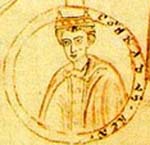Konrad (III.) (HRR)
The Salian Konrad (* 12. February 1074 in Hersfeld Abbey ; † 27. July 1101 in Florence ) was Roman-German king from 1087 to 1098 and King of Italy from 1093 to 1098. He was also 1076-1087 Duke of Lower Lorraine and Margrave of Turin .
Since Konrad was the Roman-German King only during his father's lifetime, he is not listed with his own serial number in the lists of rulers of the Holy Roman Empire; to distinguish it from other kings of the same name, the ordinal number in brackets is used. But he may not with King Konrad III. (1093 / 1094–1152) from the Hohenstaufen house can be confused.
Life
Konrad was born in Hersfeld as the second son of Emperor Heinrich IV and Bertha von Turin (an older brother, Heinrich, was born and died in early August 1071). Konrad was recognized as his father's successor at the age of two and was part of his father's walk to Canossa between 1076 and 1077. At the same time he became Duke of Lower Lorraine and was therefore preferred to the expected Godfrey of Bouillon . Konrad was left in the care of Archbishop Thedald of Milan and from then on lived in Italy.
He received the royal ordination on May 30, 1087 in Aachen . In 1093, under the influence of Margravine Mathilde von Tuszien , Konrad moved to the papal camp and thus to his father's opponents; in the same year he was crowned King of Italy in Milan . In 1095, shortly after the Synod of Piacenza, Konrad took the oath of security to Pope Urban II in Cremona and performed the strator service (leading the horse like a servant as a gesture of submission). Urban II then assured Konrad that he would be crowned emperor . In the same year Urban II (with Mathilde von Tuszien) brokered the marriage between Konrad and Konstanze, daughter of Count Roger I of Sicily .
His father reacted to these events in an imperial assembly in April 1098 in Mainz . Heinrich IV had Konrad declared deposed by a prince's court and at the same time appointed the younger son Heinrich as his successor. As a result, Konrad was hardly able to influence political events in Italy. Konrad died at the age of 27, "having become meaningless" in 1101 in Florence, where he was buried in the Cathedral of Santa Reparata , which is now overbuilt by the Cathedral of Santa Maria del Fiore .
literature
- Alfred Gawlik : Konrad, King . In: New German Biography (NDB). Volume 12, Duncker & Humblot, Berlin 1980, ISBN 3-428-00193-1 , p. 496 ( digitized version ).
- Theodor Lindner : Konrad (German king) . In: Allgemeine Deutsche Biographie (ADB). Volume 16, Duncker & Humblot, Leipzig 1882, pp. 554-556.
- Elke Goez : The heir to the throne as a rival. King Konrad, Emperor Heinrich IV's elder son. In: Historisches Jahrbuch 116 (1996), pp. 1-49.
Regesten
- Böhmer, JF, Regesta Imperii III. Salian house 1024-1125. Part 2: 1056-1125. 3rd department: The regests of the empire under Heinrich IV. 1056 (1050) - 1106. 5th edition: The regests of Rudolf von Rheinfelden, Hermann von Salm and Konrad (III.) Directories, registers, addenda and corrigenda, edited by Gerhard Lubich , with the assistance of Dirk Jäckel / Matthias Weber, and Cathrin Junker / Lisa Klocke / Markus Keller, Cologne / Weimar / Vienna 2018, ISBN 978-3-412-51149-4 , ( Digitized version ).
Web links
- Henner Göbel: Konrad, born in Hersfeld - King of Italy. ( Memento from March 12, 2016 in the Internet Archive ) In: Mein Heimatland 47 (2008), No. 4, supplement of the Hersfelder Zeitung , p. 16 (PDF; 196 kB) (irrelevant).
Individual evidence
- ↑ Claudia Zey : Wives and Daughters of the Salic Rulers. On the change in Salic marriage policy during the crisis. In: Tilman Struve (Ed.): The Salians, the Reich and the Lower Rhine. Böhlau, Cologne et al. 2008, ISBN 978-3-412-20201-9 , pp. 47–98, here p. 83 .
- ^ A b Matthias Becher : Heinrich IV. (1056-1106). With Rudolf (1077–1080), Hermann (1081), Konrad (1087–1093, † 1101). In: Bernd Schneidmüller , Stefan Weinfurter (Hrsg.): The German rulers of the Middle Ages. Historical portraits from Heinrich I to Maximilian I. Beck, Munich 2003, ISBN 3-406-50958-4 , pp. 154–180, here p. 178 .
| predecessor | Office | successor |
|---|---|---|
| Henry IV. |
Roman-German fellow-king 1087-1098 |
Henry IV. |
| Henry II |
King of Italy 1093-1098 |
Lothar III. |
| Gottfried IV. |
Duke of Lower Lorraine 1076-1087 |
Gottfried V. |
| personal data | |
|---|---|
| SURNAME | Konrad |
| BRIEF DESCRIPTION | King of Italy, co-king of Germany |
| DATE OF BIRTH | February 12, 1074 |
| PLACE OF BIRTH | Hersfeld Monastery |
| DATE OF DEATH | July 27, 1101 |
| Place of death | Florence |
